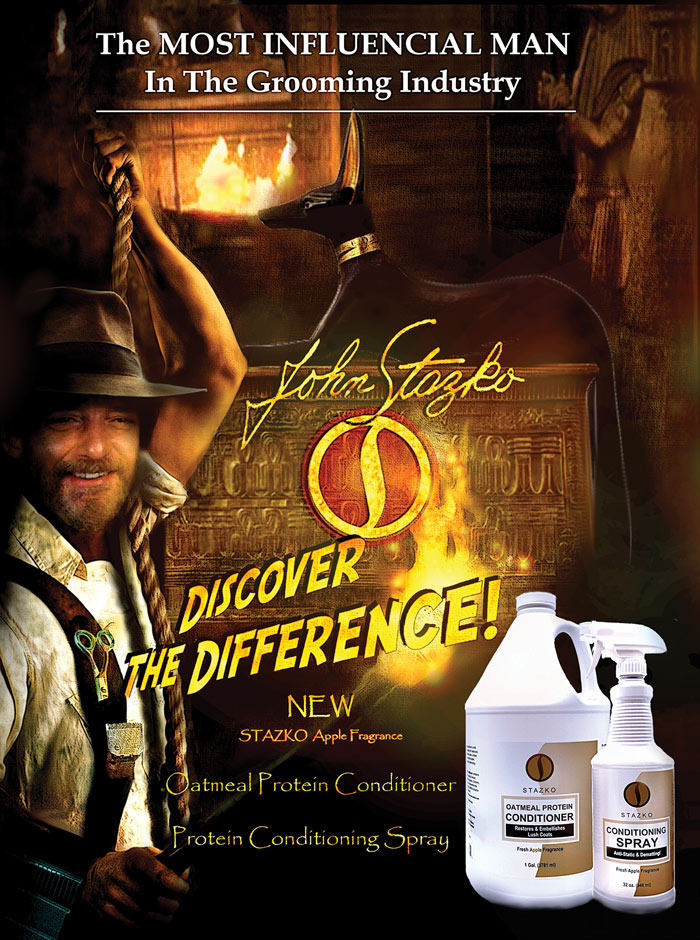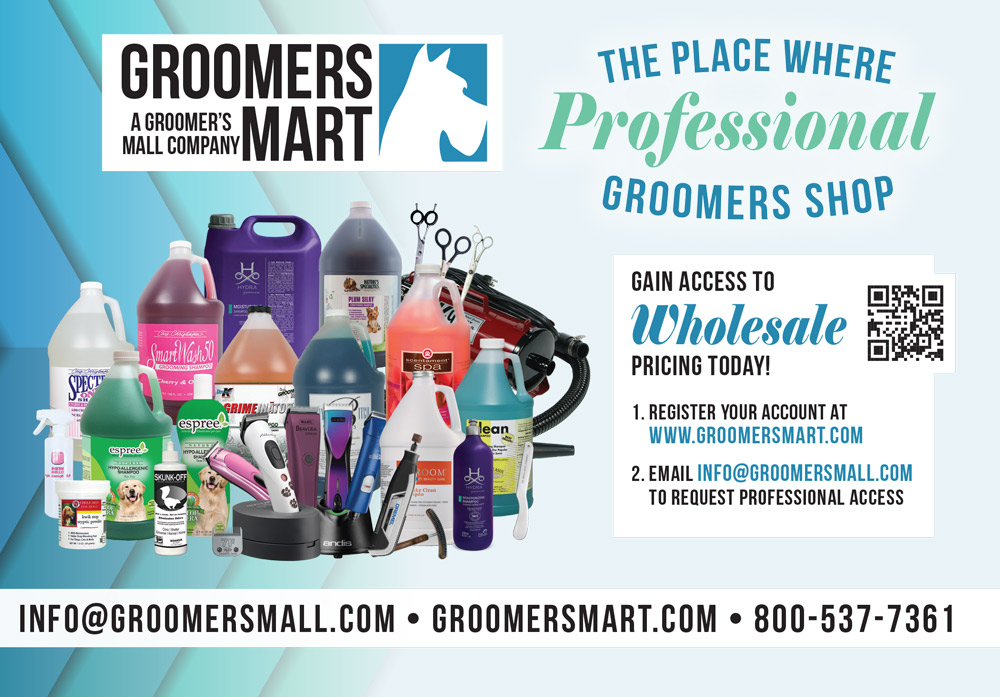


 hen we become a pet’s groomer, we are connected to a special piece of the pet owner’s family. Being close to their pet brings us into a bond with them that can last for years—and even have you sharing major life and death moments with them. In this era of online reviews and instantaneous sharing of retail experiences on social media, good communication with our human clients is critical.
hen we become a pet’s groomer, we are connected to a special piece of the pet owner’s family. Being close to their pet brings us into a bond with them that can last for years—and even have you sharing major life and death moments with them. In this era of online reviews and instantaneous sharing of retail experiences on social media, good communication with our human clients is critical.
New clients on your appointment book should get an extra 10-15 minutes of your scheduled time at their first visit. Greet the owner first with a smile and eye contact, and perhaps a handshake. A goal of your early conversation is for you to learn what the client may want from the groom, their style preferences, etc. But even more importantly, this is your opportunity to demonstrate your expertise about what the needs of this breed’s coat type are.
If this is the first time this client has ever owned a dog or encountered a professional pet groomer, they might not know about the importance of monthly grooming for any dog or cat, so it’s important to explain the necessary routine to keep the skin and coat healthy. Also, you may want to explain the critical importance of frequent nail trims and its relationship in dogs to long-term arthritis and orthopedic issues if neglected. And depending on the dog’s coat type, explain any home grooming they should be doing in between visits. If you can sell retail items, be prepared to offer some of those home grooming items that you recommend.
Explain that hair-type dogs require regular trimming and have a tendency to mat or tangle, especially during “coat change” or puberty when the matting and tangling can happen rapidly and intensely. If it is a fur-type coat, explain shedding and its seasonal relationship to the solstices on the calendar, as well as the importance of never shaving a fur-type coat on those breeds.
By showing your expertise on the proper care and unique needs of their individual dog’s coat, you will quickly be able to establish both your authority and your trustworthiness in taking care of their dog. Similar principles apply when discussing cats’ or other small mammals’ grooming services.
By showing your expertise on the proper care and unique needs of their individual dog’s coat, you will quickly be able to establish both your authority and your trustworthiness in taking care of their dog.
Never reach down to pet the dog on their head. This is very domineering body language. Instead, if they indicate an interest or willingness with their body language, reach under their chin to pet their chest area. Perhaps the dog will be interested in smelling you. Let them. That is how dogs identify everything in their environment. Smell is their primary sense.
If you must pat down the coat to check for mats or other aspects of the dog’s physical condition, make sure that your initial physical contact with them is done in this non-threatening manner. As they become comfortable with you touching them, start with reaching to the lower areas under the head. If possible, get down to the dog’s level. Talk to the dog, smiling and saying its name while still talking to the owner about what you wish to communicate or learn about the grooming process for this new dog and its family.
Good customer service will include questions to the owner as to their preferences. Asking them questions shows that you care about their desires and goals. Find out about the dog’s age, health, personality and background. Ask them about previous grooming experience, as well as what they do at home regarding grooming.
Ask about their lifestyle and what activities they engage in with their pet in order to learn more about how the coat may be affected in between grooms. For example, a number of my clients take their dogs to beaches or lake houses for summer vacations. Dogs that swim in lakes can develop a number of issues such as bacteria, lake “gunk” stuck in their coat and, as with any water on a longer coat, matting. The more you know about their lives with their dogs, the more helpful those grooming conversations will be.
All groomers should have a signed liability release or customer contract that clearly lays out obligations and contingencies. It is advisable to seek an attorney’s assistance in writing these documents, which could be critical at a time of difficulty when dealing with live animals. Shot records are usually a legal requirement as well.
It is also equally important that you establish the schedule you will be putting their pet on for grooming and your ground rules in the conduct of your business. Post-pandemic, we groomers are in a much stronger position than ever before to direct the grooming schedules and decisions of our clients given the increased demand for our services in recent years. I now require, rather than recommend, a monthly schedule for all my dog grooming clients.
Make sure that you give any procedural or safety rules for the conduct of your business. And, it is best if those are posted or printed in some visual way, perhaps on both your website and social media platforms, as well as signs in your lobby if you have a salon, or on a handout or flyer. If you are clear in writing with these expectations upfront, customers cannot later deny they did not know.
In my years of training to become a career schoolteacher, I gained a lot of insight into how people learn and absorb information. There are a variety of different dominant learning styles, but most people are visual learners; what they SEE is what they best remember, retain and understand.
Discussing what you are showing them while providing some sort of visual gives auditory reinforcement to what you want them to learn. Getting them to verbally answer questions as you discuss their plans to work with your grooming program gives even more solidity to your communication, but showing them in a visual way is what will seal the deal.
Creating what I used to call as a teacher a “graphic organizer” can greatly improve your customer service through much more effective communication. One example of a visual communication aid when discussing the groom with clients is the “Fifteen Coat Types” poster that I created which connects canine coat type genetics with veterinary dermatology and grooming coat type differences. By putting them in a color-coded chart arranged in boxes that show the relationship between those aspects of dog coat care, I lend both authority and ease of understanding to conversations about what is best for the care of their dog’s coat. You can create a chart or other visuals to highlight the guiding principles of your grooming process.
Our time is money. Anything that we can do to have excellent communication with clients in a more time-efficient way is best for our bottom line. Since most people are visual learners, having photos of different dogs with different coat types and what certain breeds are supposed to look like can greatly facilitate discussion with clients. Photos of your work and some of your more common styling choices will only improve the exchanges you have with your clients.

The “grooming price triangle” diagram allows you to explain the price of the groom as being totally dependent on the other factors of frequency of grooming visits and the length, texture, thickness and condition of the dog’s coat.
Perhaps the most difficult area of customer communication is discussing the price of the groom. One of most common problems I read about on groomer social media is self-reporting from groomers that know they need to raise their prices but are reluctant, scared or worried about doing it. I created a graphic organizer to provide a visual that powerfully facilitates client communication around the issue of price.
The “grooming price triangle” diagram (Fig. 1) allows you to explain the price of the groom as being totally dependent on the other factors of frequency of grooming visits and the length, texture, thickness and condition of the dog’s coat. These three factors are inextricably linked. And, all pricing should be based on your time and effort needed to complete the groom.
If they want a lower price and their dog has longer, thicker, more time-consuming coat to groom, they need to come in more often, cut the coat a bit shorter or do more home grooming (or all three). If they want a longer cut and the hair is thicker and more prone to matting, the price will be higher. If they don’t come in regularly, the price or the cut will change, depending on the length, texture and thickness of the coat. The connection between price, the dog’s coat and their appointments is clearly established. Once you show your clients this diagram, the conversation about price becomes easier.
This diagram is for you to use, copyright free. Feel free to recreate it for your own use in whatever manner works best for your business. You can easily recreate this visual in any format that matches your grooming business’s materials, brands or logos.
The pets that you groom will become the beneficiary of your excellent client communication!



